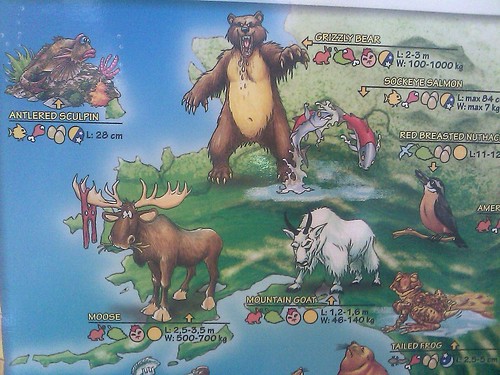
Animals in the map:
Antlered sculpin. The Pacific staghorn sculpin, Leptocottus armatus, is a common sculpin (Cottidae) found in shallow coastal waters along the Pacific coast from Alaska to Baja California. The sole member of its genus, it is unusual for having spined antler-like projections on its gill covers; it can raise the projections as a defense mechanism. Staghorn sculpins are slender fish, with a grayish olive above, pale creamy yellow sides, and a white belly.
Grizzly bear. The grizzly bear (Ursus arctos horribilis), also known as the silvertip bear, is a subspecies of brown bear (Ursus arctos) that lives in the uplands of western North America. This subspecies is thought to descend from Ussuri brown bears which crossed to Alaska from Eastern Russia 100,000 years ago.
Sockeye salmon. Sockeye salmon (Oncorhynchus nerka), also called red salmon or blueback salmon, is an anadromous species of salmon found in the Northern Pacific Ocean and rivers discharging into it. Sockeye salmon is the third most common Pacific salmon species, after pink and chum salmon. The name "sockeye" is believed to be a folk adaptation of the anglicization of sθə́qəy̓, its name in Halkomelem, the language of the indigenous people along the lower reaches of the Fraser River.
Red-breasted Nuthatch. The Red-breasted Nuthatch, Sitta canadensis, is a small songbird. Their breeding habitat is coniferous forests across Canada, Alaska and the northeastern and western United States. They excavate a nest in dead wood, often close to the ground. They smear the entrance to their nest with pitch. These birds are often permanent residents, but they regularly migrate into the southern United States if the food supply fails. There is also a White-breasted Nuthatch.
The nuthatches are a genus, Sitta, of small passerine birds belonging to the family Sittidae. Characterised by large heads, short tails, and powerful bills and feet, nuthatches advertise their territory using loud, simple songs. All members of this genus nest in holes or crevices. Their habit of wedging a large food item in a crevice and then hacking at it with their strong bills gives this group its English name.
Moose. The moose (North America) or European elk (Europe) (Alces alces) is the largest extant species in the deer family.

Overview map.
References:
Wikipedia, public domain.
Children's Map of the World (Dino's Children's Laminated Illustrated Maps). Amazon.
Animals of the World (Dino's Children's Laminated Illustrated Maps). Amazon.
DINO'S MAPS: Illustrated Children's Maps http://goo.gl/DsmP
Amazon.com: Dino's Children's Laminated Illustrated Maps http://goo.gl/358l
Another World, Another Planet: Alaska’s North - Slide Show - NYTimes, 2012.
DINO'S MAPS: Illustrated Children's Maps http://goo.gl/DsmP
Amazon.com: Dino's Children's Laminated Illustrated Maps http://goo.gl/358l
Another World, Another Planet: Alaska’s North - Slide Show - NYTimes, 2012.
No comments:
Post a Comment